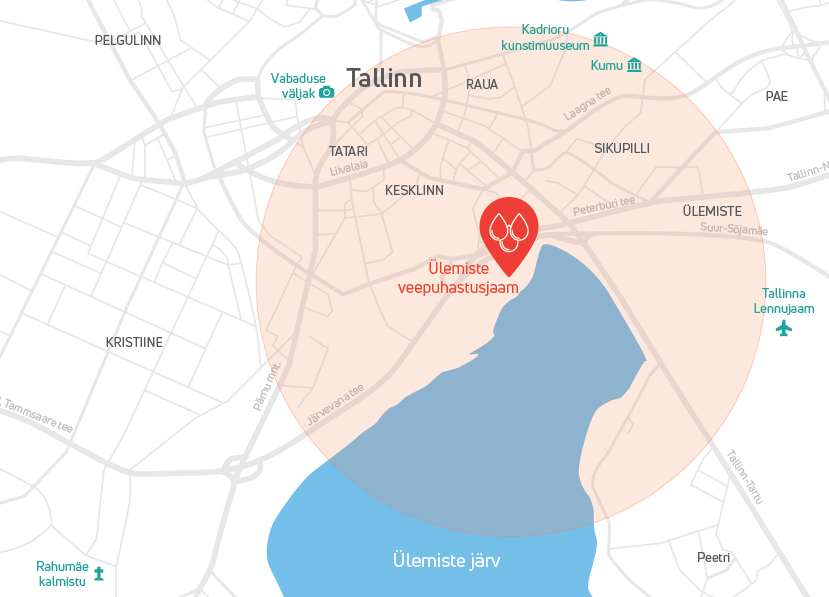Chlorine emergency
Under the Chemicals Act, we provide information on the potential major accident hazard and share initial operational guidance in the event of a chlorine accident at the Ülemiste Water Treatment Plant. Tallinna Vesi will do its utmost to ensure that the risk of the accident is hedged, following all safety requirements both in the transport, storage and use of chlorine.
Water Treatment Plant at Ülemiste treats surface water to produce drinking water. In this process, chlorine is used on disinfecting purposes. The Technical Regulatory Authority has issued an activity licence number OKK-19-11 to AS Tallinna Vesi on 28.11.2011 for an unspecified term. The handler of the hazardous chemical is AS Tallinna Vesi’s Water Treatment Plant at Järvevana Road 3, Tallinn. Due to the storage and usage of chlorine, our water treatment plant has been classified as a category B company with a risk of a major accident. Chlorine used at the treatment plant can cause a major accident in case of an extensive chlorine leakage in the chlorine storage.
AS Tallinna Vesi has prepared and provided to the competent national authorities a chemical data sheet, a risk assessment (adjusted assessment approved by the Technical Regulatory Authority on 24.09.2018), a description of the safety assurance system (approved by the Technical Regulatory Authority on 17.05.2017) and a contingency plan (approved by the Rescue Board on 21.04.2017). Additional information on the inspection plan can be obtained from the Rescue Board or the Consumer Protection and Technical Regulatory Authority. The Technical Regulatory Authority last checked the company activities for the compliance with the requirements set out in the Chemicals Act on 16.05.2017 and found no non-compliances. A comprehensive chemical safety data sheet has been prepared by AS Ingle on 11.12.2012, as last amended in December 2018 in accordance with the Regulation (EC) No 1907/2006 and Regulation (EC) No 1272/2008 of the European Parliament and of the Council.
Various protection mechanisms exist to control hazards. We arrange regular training sessions and excercises for our employees. Also, we have an ongoing cooperation with the Northern Rescue Centre of the Rescue Board, in order to be ready to respond quickly in the event of a major accident.
The figure below illustrates the danger zone in case of a chlorine emergency:

Chlorine gas is toxic and suffocating when inhaled, it irritates the eyes, skin and respiratory system. Chlorine has a strong oxidising effect and is extremely toxic to aquatic organisms.
Chlorine gas is greenish yellow, with a pungent odour, heavier than air. A cloud of chlorine gas spreads downwind of a leaking point. When joining the steam in the air, it forms a white fog. Spreading downwind, it settles in lower-lying areas, ditches and underground communications. With raising air flows, it vanishes into atmosphere.
How to behave in the event of a chlorine emergency?
- When you hear the siren, leave the danger zone, moving further away by crossing the wind direction.
- If possible, go inside and stay there. Close the doors and windows, vents and ventilation.
- Inform you neighbours about the danger.
- Start using a wet towel or some other textile material for breathing when you smell the chlorine. Use the shower in case of a strong chlorine odour, as water will neutralise the chlorine gas.
- In the event of an emergency, follow all the instructions given by the rescue services.
How to recognize the signs of intoxication?
- Chlorine causes damage to tissues, irritates the mucous membranes, causes nonproductive coughing, sneezing, and sometimes also vomiting.
- Higher concentrations may cause chest pain, tearing and abnormal coordination.
Handler of the hazardous chemical: AS Tallinna Vesi, Water Treatment Plant, Järvevana Road 3
Information on safety precautions and other chlorine–related information: Water Treatment Plant Manager ph 62 62 510; Chief Technologist: ph 62 62 610